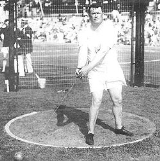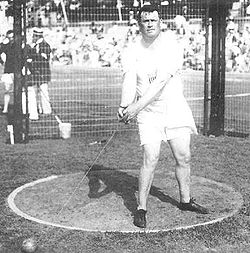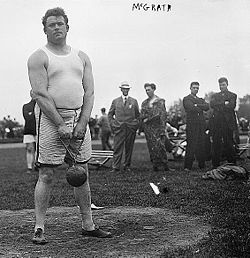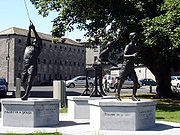
Matt McGrath
Encyclopedia

Irish American Athletic Club
The Irish American Athletic Club was an amateur athletic organization, based in Queens, New York at the beginning of the 20th Century.-Early years:...
, the New York Athletic Club, and the New York City Police Department
New York City Police Department
The New York City Police Department , established in 1845, is currently the largest municipal police force in the United States, with primary responsibilities in law enforcement and investigation within the five boroughs of New York City...
. At the time of his death at age 65, he attained the rank of Inspector, and during his career received the NYPD's Medal of Valor twice. He competed for the U.S. team in the Olympics in 1908, 1912, 1920 and 1924 (at age 47). In his prime, he was known as "one of the world's greatest weight throwers."
McGrath was born in Nenagh
Nenagh
Nenagh is the county town of North Tipperary in Ireland. It is the administrative centre of North Tipperary and in 2011 it had a recorded population of 7,995. It is a civil parish in the historical barony of Ormond Lower...
, County Tipperary
County Tipperary
County Tipperary is a county of Ireland. It is located in the province of Munster and is named after the town of Tipperary. The area of the county does not have a single local authority; local government is split between two authorities. In North Tipperary, part of the Mid-West Region, local...
, Ireland
Ireland
Ireland is an island to the northwest of continental Europe. It is the third-largest island in Europe and the twentieth-largest island on Earth...
, and later immigrated to the United States. During his competitive years he stood 5′ 11½″ (1.82 m) tall and weighed 247 lb (112 kg), and was part of a group of large and dominant throwers referred to as the Irish Whales
Irish Whales
The Irish Whales or "The Whales" was a nickname given to a group of Irish and Irish-American athletes who dominated weight-throwing events in the first two decades of the 20th Century...
.

Hammer throw
The modern or Olympic hammer throw is an athletic throwing event where the object is to throw a heavy metal ball attached to a wire and handle. The name "hammer throw" is derived from older competitions where an actual sledge hammer was thrown...
until age 27, when he ranked seventh on the world list of best marks. He remained in the world’s top ten up to the age of 50, making his career one of the longest and most consistent in the history of the sport. He won seven AAU hammer throw championships, won seven more in the little-contested 56-pound weight throw
Weight throw
The weight throw is a track and field event that is held at Scottish Highland games and occasionally at indoor track meets.In the Highland Games, the weight throw consists of two separate events, the light weight and the heavy weight. In both cases, the implement consists of a steel or lead weight ...
, and set two hammer throw world records. His lifetime best throw was the second of those records, 187′ 4″ (57.10 m), made at New York
New York
New York is a state in the Northeastern region of the United States. It is the nation's third most populous state. New York is bordered by New Jersey and Pennsylvania to the south, and by Connecticut, Massachusetts and Vermont to the east...
’s Celtic Park on October 29, 1911.

World record
A world record is usually the best global performance ever recorded and verified in a specific skill or sport. The book Guinness World Records collates and publishes notable records of all types, from first and best to worst human achievements, to extremes in the natural world and beyond...
holder and took second behind John Flanagan's third consecutive victory. In 1912 McGrath won the Olympic title in dominating fashion (the shortest of his six throws was over 15 feet (4.5 m) longer than any other competitor's best throw) and set an Olympic record that stood for 24 years.
At the 1920, Olympics McGrath was a co-favorite along with fellow Irish American Athletic Club
Irish American Athletic Club
The Irish American Athletic Club was an amateur athletic organization, based in Queens, New York at the beginning of the 20th Century.-Early years:...
member Patrick Ryan
Patrick Ryan (athlete)
Patrick James Ryan was an Irish hammer thrower who won the Gold medal as a member of the U.S. Olympic team at the 1920 Summer Olympics in Antwerp, Belgium, winning the event by the biggest winning margin in history...
, but finished fifth after injuring his knee during the competition. In 1924 he again took the silver medal, setting (and still holding) the standard for the oldest American track and field medalist ever. An off day at the 1928 Final Olympic try-outs barely kept him off the 1928 Olympic team. There was a public outcry over McGrath's omission from the team and although he went to Amsterdam after a subscription fund had been raised to pay for his transportation, he was, not surprisingly, not allowed to compete.
In September 2002, the town of Nenagh, County Tipperary, Ireland erected a statue honoring McGrath's Olympic achievements in the town square.

